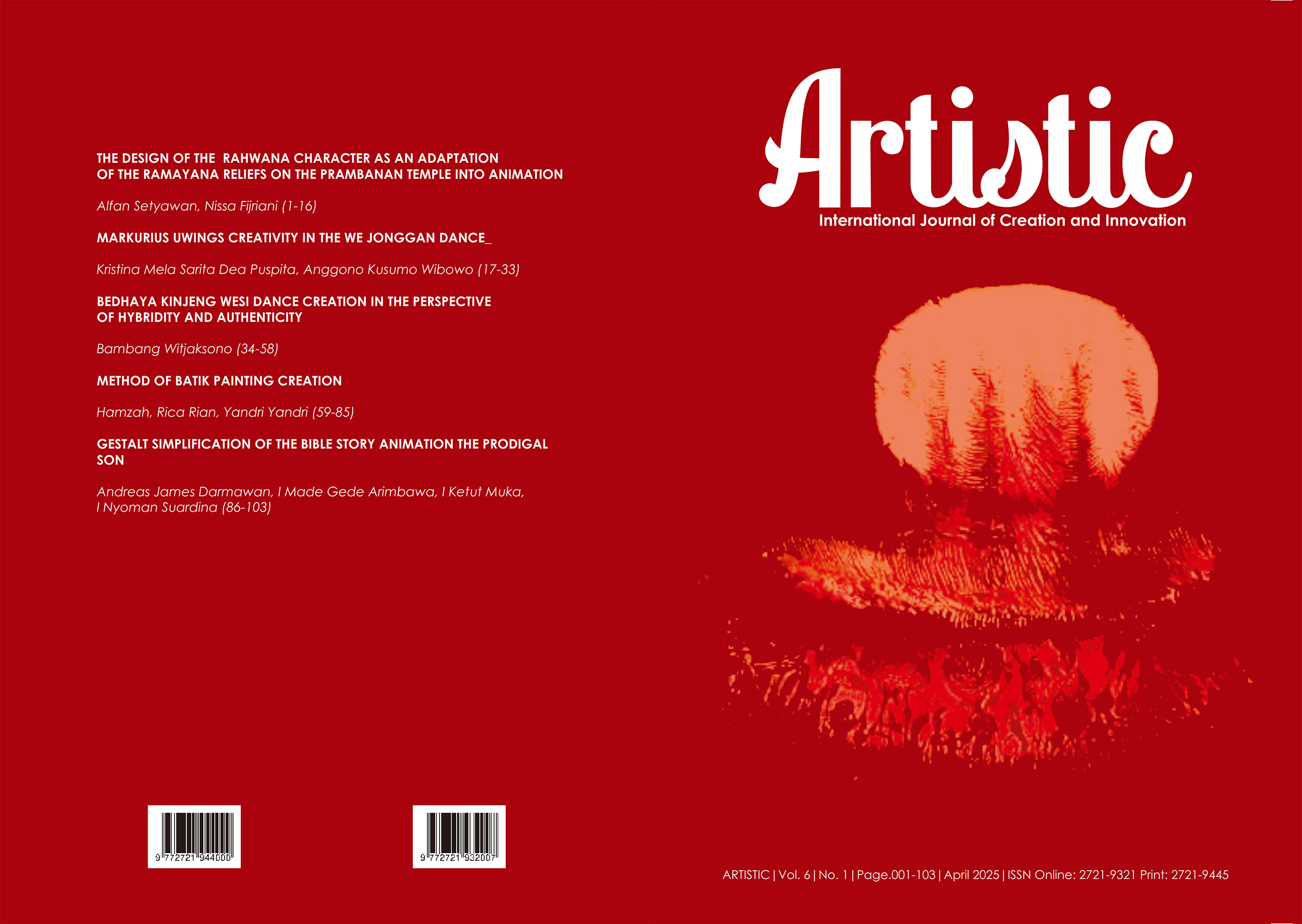THE DESIGN OF THE RAHWANA CHARACTER AS AN ADAPTATION OF THE RAMAYANA RELIEFS ON THE PRAMBANAN TEMPLE INTO ANIMATION
DOI:
https://doi.org/10.33153/artistic.v6i1.6392Keywords:
Prambanan Temple, Rahwana, character, animation, IndonesiaAbstract
The Ramayana reliefs on the walls of the Shiva and Brahma temples within the Prambanan temple complex serve as a visual narrative that depicts Rama's journey to rescue Dewi Sinta from Rahwana. The visual appearance of the relief represents an acculturation of Indian and Javanese cultures. The narrative imparts lessons on the concept of morality through the portrayal of people representing both good and evil. This article intends to conceptualize the character of Rahwana from the perspective of the Ramayana reliefs as an animated character design. This design employs the Visual Language (Bahasa Rupa) and Adaptation (Alihwahana) approaches through data collecting, translation, and work compilation phases. This design's outcome is the Rahwana design, featuring body decoration, color, and the configuration of the Dasamuka and a T-Pose. This character design offers the possibility for further development to meet the requirements of animated film production with Indonesian characteristics
Downloads
References
Abimanyu, P. (2014). Ajaran-ajaran Emas Ramayana-Mahabharata [The Golden Teachings of Ramayana-Mahabharata]. Yogyakarta: Laksana.
Aditya. (2009). Trik Dahsyat Menjadi Animator 3D Handal [Awesome Tricks to Become a Skilled 3D Animator]. Yogyakarta: Penerbit Andi.
Afida, G., Lutfianti, A., Amalia, I. (2022). Eksplorasi Bahasa Warna pada Karakter Emosional Film Animasi Inside Out [Exploring the Language of Color in the Emotional Characters of the Animated Film Inside Out]. Jurnal ATRAT: Jurnal Seni Rupa, 10(2), DOI: https://doi.org/10.26742/atrat.v10i2.1823.
Bishop, R. D., Boo, S., Cruz, M. R., Gadea, L. (2020). Fundamentals of Character Design: How to Create Engaging Characters for Illustration, Animation & Visual Development. 3dtotal Publishing.
Caroline, W. M. (2024). Desain Karakter Tokoh Animasi [Animated Character Design]. Semarang: Yayasan Prima Agus Teknik.
Damono, S. D. (2016, 2018). Alih Wahana [Adaptation]. Jakarta, Indonesia: Gramedia.
Engländer, F. 2015. The T-pose – all about this mighty blueprint. Animator Island. https://www.animatorisland.com/the-t-pose-all-about-the-mighty-blueprint/.
Jordan, R. (2009). Memuji Prambanan [Praising Prambanan]. Jakarta, Indonesia: KITLV.
Maulana, R. (1985). Ikonografi Hindu [Hindu Iconography]. Jakarta: Fakultas Sastra Universitas Indonesia.
Neelakantan, A. (2019). Rahwana Kisah Rahasia [Rahwana Secret Story]. Pamulang, Indonesia: Javanica.
Rahardjo, S. (2011). Peradaban Jawa: dari Mataram Kuno sampai Majapahit Akhir [Javanese Civilization: from Ancient Mataram to Late Majapahit]. Depok: Komunitas Bambu.
Soebroto, B. G. (2016). Kajian Estetika Relief Candi di Jawa Timur [Aesthetic Study of Temple Reliefs in East Java]. Yogyakarta: Graha Ilmu.
Soekmono. (1981). Sejarah Kebudayaan Indonesia [History of Indonesian Culture]. Yogyakarta, Indonesia: Kanisius.
Tabrani, P. (2005). Bahasa Rupa [Visual Language]. Bandung, Indonesia: Kelir.
Veriansyah, W. S., Sugihartono, R. A. (2020). The Directing Animation Film Entitled Si Joe. ARTISTIC: International Journal of Creation and Innovation, 1(1), 55-74, DOI: https://doi.org/10.33153/artistic.v1i1.2994.
Wright, J. A.. (2005). Animation Writing and Development From Script Development to Pitch. UK: Elsevier Inc.
Downloads
Published
How to Cite
Issue
Section
License
Copyright (c) 2025 alfan setyawan alfan, Nisa Fijriani Nisa

This work is licensed under a Creative Commons Attribution-NonCommercial-ShareAlike 4.0 International License.
Copyright
Authors who publish with Artistic agree to the following terms:
- Authors retain copyright and grant the journal right of first publication with the work simultaneously licensed under a Creative Commons Attribution License (CC BY-SA 4.0) that allows others to share the work with an acknowledgment of the work's authorship and initial publication in this journal.
- Authors are able to enter into separate, additional contractual arrangements for the non-exclusive distribution of the journal's published version of the work (e.g., post it to an institutional repository or publish it in a book), with an acknowledgment of its initial publication in this journal.
This work is licensed under a Creative Commons Attribution-ShareAlike 4.0


